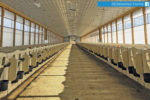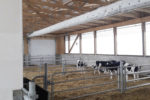Calf Housing
Getting cozy: Pair-housing calves as a potential solution to cold stress
Pair-housing calves may help reduce cold stress during winter in outdoor hutches while also improving calf welfare with social contact.
Read More
The weather forecast for today is hot and cold: Tips for nurturing calves in fluctuating weather
While pretty much no one likes it when the weather turns bipolar, calves find it especially challenging. Whether the calf is facing heat or cold, minimizing stressors is essential to maximizing calf performance.
Read More
4 tips to foster a positive impact on calf stress
Preventative measures like good nutrition, handling practices, calf comfort and observation protocols are key for keeping calves healthy while they're stressed.
Read More
Can your calves pass these tests?
While every operation is different, key tests and measurements can indicate a farm’s ability to raise calves well. These include passive transfer, feeding hygiene, housing cleanliness and comfort, and a calf’s growth rate and health markers.
Read More
Calves can vote too: Preferences for hutch ventilation during summer
Study shows that by 6 weeks old, calves show a significant preference for ventilated hutches, and ventilated hutches can help reduce heat stress. Additionally, pair-housed calves spent 80% of their time together.
Read More
Calves under the sun: Navigating heat stress challenges
Heat stress can have lifelong negative impacts on calf health and performance. Shade, air flow, the THI chart and electrolytes are all essential tools for mitigating this issue.
Read More
Ventilating repurposed structures for calf housing
Existing barns can often be retrofitted into excellent calf housing. However, care must be taken to ensure proper ventilation, pen layout and fresh-air distribution to promote good calf health and performance.
Read More
Maximize the effectiveness of calf barn ventilation with computerized calculations
What if a farm could run multiple scenarios with barn layout to find their perfect design before pouring a drop of concrete or driving a single screw? Using new software called computational fluid dynamics, now they can.
Read More
Managing natural ventilation in your calf barn
Tips to keep calves comfortable and healthy this winter by managing interior temperature, minimizing drafts and maintaining air flow.
Read More


.jpg?height=125&t=1727143060&width=150)




